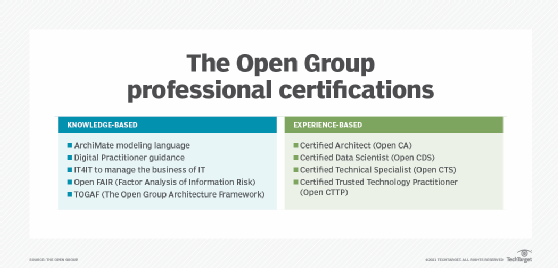
Konstantin Emelyanov - Fotolia
Open Group turns focus to TOGAF, Agile architecture guidance
The Open Group's Steve Nunn discusses upcoming work to improve its Open Agile Architecture standard and TOGAF guides as well as COVID-19's impact on enterprise architecture.
The Open Group will add deeper content to its new Open Agile Architecture standard moving forward and offer more guidance on how to use it with TOGAF and the vendor-neutral consortium's other standards.
TOGAF -- shortened from The Open Group Architecture Framework -- is the organization's most popular standard, with more than 100,000 professionals certified through exams that they have increasingly taken from home in the wake of the COVID-19 pandemic.
Steve Nunn, president and CEO of The Open Group, took stock of the latest Agile, TOGAF and other enterprise architecture developments in this interview with SearchAppArchitecture.
What are the most important trends you're seeing with your members and enterprise architecture in general?
 Steve Nunn
Steve Nunn
Steve Nunn: The first one is Agile. How do Agile and enterprise architecture play together? There's a school of thought that in a world that requires Agile methods, there's no place for what some people call the waterfall approach to architecture -- the traditional, big-plans-upfront approach.
We, as an organization, have been following it with interest for some years now, and there is absolutely nothing about the TOGAF standard that can't be used in an Agile way. There's a perception there are all these steps or phases to go through, and it's heavyweight. But we have plenty of evidence of how it can be used in timeframes that are completely consistent with Agile approaches, scrums, standups and all sorts of those approaches. So, you'll see more guidance about how TOGAF can be used in that way coming out from us over the course of this year.
Also, we launched the Open Agile Architecture (OAA) standard that's completely different to TOGAF in intent, but can be used in synergy. OAA will hopefully help people who believe that enterprise architecture and TOGAF are incompatible with Agile see that we still need architecture. We've seen examples of large organizations wiping out their enterprise architecture departments and saying, 'We're doing Agile.' They're now saying, 'We still need architecture, because we developed a lot of stuff quickly, but it wasn't coordinated. We've got disparate parts now that we need to bring together.' Guess what? The way to do that is architecture.
I would also stress there's quite often a lot of confusion between agility in a software development sense and the methods that are used. Organizational agility is required for digital transformation, and you don't get that by just following Agile software development approaches. You get that by following Agile architecture techniques.
What feedback have you gotten on OAA since it became final in September?
Nunn: Does this mean there's no further evolution of TOGAF? The answer is absolutely not.
The other feedback we've gotten is: It's great as far as it goes, but there needs to be a bit more depth in the standard -- which is something I completely understand. The members who worked hard on it understand that, too. So, they have a roadmap for adding more depth and content to the standard. They're following what they call a playbook approach. For example, they've been working with our security forum on the security playbook for the OAA.
The other feedback we've gotten is: There's TOGAF, OAA, IT4IT and other Open Group standards. How do I go about using them together? Or, when do I use one and not the other? We've kicked off an activity to look at a portfolio of digital standards. How do these standards play together in a way that's useful when you're going through a digital transformation journey inside your organization? A lot depends on where you start. One of the key components of bringing the portfolio together is the digital practitioner body of knowledge, which is aimed at the approaches you need to take at different parts in your organization's lifecycle.

Do you ever worry the volume of material that The Open Group puts out could overwhelm people who are just getting started?
Nunn: Years ago at our physical events, we used to run a session quite regularly called 'I've downloaded TOGAF. Now what?' Just that standard alone is 800 pages or thereabouts. There's a lot to absorb. That's why guidance material is important. Everyone wants case studies. That's one of the values people got from attending our physical events -- the opportunity to discuss those things with other people who've been in a similar situation. It was more than just networking.
What we try to do, where it makes sense, is run a user group aimed at people asking questions about how to get started. We also get things out through white papers and blogs. There are people who consult on that, of course. We're not a consultancy. We don't profess to advise people on how to do their architecture work. We just try to provide the tools to help them. All of this stuff is freely downloadable and usable. They may need help to implement it sometimes. Another way of doing that is through training and certification. We advise getting at least some people trained in these standards. If they then train their colleagues, you've got a common language so that you can immediately get value from just that alone.
The other thing that's new is the Architect's Toolkit we put on our website late last year. That is intended to acknowledge the fact that all these standards are tools. You don't have to follow them slavishly, and you don't have to use one particular tool to do everything. You pick the best tool for the task or situation.
Do you have any sense how many organizations buy enterprise architecture tools?
Nunn: There's quite a number of tools vendors. Some tools are pretty expensive. What I've seen over the years with case studies at our events is people tend to start small. They might start with a free tool. They make the case inside an organization for the value of modeling and the value of a tool, to help them get the budget to buy a more sophisticated tool with greater functionality. Of course, larger organizations with big budgets may go straight into buying a major tool.
If you try to do real enterprise architecture without tools, you only get so far -- or you need a lot of people, because capturing things in PowerPoint and other non-EA tools gets complicated quite quickly. So, the tools are an important part of the architecture work that goes on. As we see the demand for EA go up, the demand for tools is going up, too.
What's the most profound impact you've noticed as a result of the COVID-19 pandemic?
Nunn: A key role of an architect is bringing together the technical side of the house and the business side of the house -- the stakeholders -- and communicating. Typically, that's done face-to-face, maybe with lots of Post-it notes all over the place, getting people's pain points down. I've heard that function is just harder to deliver effectively in a virtual sense. I'm sure there are ways of doing it, but you still don't get that same connection that you would have if you were running a session in a room.
A very positive difference is the demand for enterprise architecture has gone up in no small part because of the place it plays and the value it adds to digital transformation. From what I've read -- and we've had speakers mention it -- digital transformation in many organizations has been greatly accelerated by COVID-19, because of the need to deliver products and services in a digital or no-touch way to customers. One of the big analyst firms said COVID-19 had probably accelerated digital transformation by two or three years in the case of many organizations out of complete necessity. They were probably down that path, but they've really had to adapt and accelerate their digital transformation. It's a question of survival.
Have you sensed increased hiring of enterprise architects?
Nunn: Yes. I've got anecdotal evidence from some of our member organizations, particularly the large ones. They've literally said, if the value of enterprise architecture was being questioned in the face of everything being Agile, then it's flipped completely. Now they're struggling to cope with the demand for enterprise architects in their organizations. Even some organizations that instituted hiring freezes during the last year because of the pandemic are often making exceptions when it comes to enterprise architects, because they see it as a valued skill.
What will be the most important areas of focus for The Open Group moving forward?
Nunn: We'll be coming out with a number of new TOGAF series guides during the course of this year. A lot of the work in our architecture forum is going into guidance on how to use TOGAF in different environments or in connection with other standards, because that's really what people are telling us they're looking for.
IT4IT version 3.0 is going to be significant with a focus on digital product management. The Open Footprint Forum is tackling what we can do to help fight climate change, or at least keep track, and reduce carbon and other energy emissions. That work is important and might actually be one of the relatively rare occasions where The Open Group gets noticed in the world outside our community.
Before then, the [Open Subsurface Data Universe] OSDU Forum is going to launch the first mainstream version of the open source implementations of their standard. It's in the subsurface part of the oil and gas industry that is fundamentally changing the way data is used from exploration to make it far more analyzable. The forum has grown quickly, and just about everyone who is anyone in that industry is involved. They have more work to do, but I think that will be a significant step forward.
As a general pointer, a key theme for this year and going forward is the use of open standards to help solve specific business problems or build a next generation of systems that are based on those standards, with all the benefits that openness brings.
Editor's note: This interview was edited and condensed for length and clarity.








